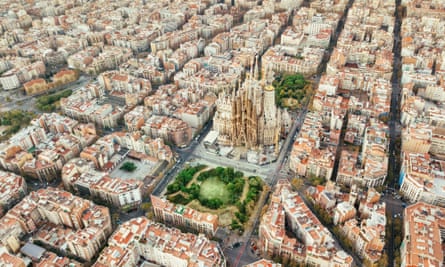Barcelona’s Sagrada Familia basilica has a new completion date of 2026, which will come 144 years after the first stone was laid.
The president of the organisation tasked with completing Antoni Gaudí’s masterwork announced the date last Wednesday, which coincides with the centenary of the death of the building’s architect.
Esteve Camps said they had the money and material to finish the building, including the 172.5-metre central tower dedicated to Jesus Christ, making the Sagrada Familia Barcelona’s tallest building.
Although the building is set to be complete by 2026, work on sculptures and decorative details and, above all, the controversial stairway leading to what will eventually be the main entrance, is expected to continue until 2034.
When work began in 1882 the site was open farmland but in the intervening years the city has grown up around the church. The stairway, which would extend across two large city blocks, would involve dislodging about 1,000 families and businesses.
While some Gaudí scholars dispute it, Camps insists that the stairway was always part of the architect’s plan.
“We are following Gaudí’s plan to the letter, he said. “We are his heirs and we can’t renounce his project. The plan presented to the local authority in 1915, which was signed by Gaudí, includes the stairway.” He added that they were in talks with the mayor of Barcelona, Jaume Collboni, over the plan, as the local authority has the last word. “I don’t have a crystal ball to tell me when they will make a decision,” he said.
Since its inception, the Sagrada Familia has been dogged by war, neglect and a lack of finance. Most recently, the Covid pandemic led to a two-year hiatus in work on the site.

Before the advent of mass tourism, work was to be funded exclusively by donations from repentant sinners, which made cashflow unpredictable and many doubted that the work would ever be completed. The poet Joan Maragall described the basilica as “the poetry of architecture … a temple that will never be finished, that is constantly becoming”.
For decades now, tourism has guaranteed a steady income, with close to 5 million visitors a year paying €25-40 (£20-£32) a visit. Slightly more than half of the €125m this brings in goes to completing the work. How the rest is spent remains a mystery as the church is not obliged to publish its accounts.
In 1936, at the start of the Spanish civil war, anarchists set fire to the crypt and destroyed Gaudí’s workshop and the plaster models he made as a guide for his successors to complete the work. The architect Lluís Bonet i Garí rescued the fragments and Gaudí’s models were painstakingly reassembled. Many of the technical details of how to realise Gaudí’s design were later ironed out by the New Zealand architect Mark Burry using aeronautical software.
The Sagrada Familia is regarded as one of the wonders of the modern world but that wasn’t always the case. Salvador Dalí described its “terrifying and edible beauty” while George Orwell considered it “one of the most hideous buildings in the world” and commented that the anarchists showed a lack of taste for failing to blow it up when they had the chance.
